#Sensorama
Explore tagged Tumblr posts
Text

Invisible Waves 010
10-03-2024
INTRO 00:00
Alexander R. Cargill Esq.-Bromham Carnival Queen, 1967. 00:10 CHAPTER 1 04:12
IDRA-Ritual II 05:47 Site Nonsite-Institute for Nature Study (Fresh Air Mix) 12:56 CHAPTER 2 17:42
Underworld-To Heal 20:22 Dean Honer-De Da Dumplings 22:53 Khotin-Computer Break (Late Mix) 24:19 CHAPTER 3 28:43 Mark Ellery Griffiths-The Faith Healer 31:39 Vic Mars-The Fair Arrives 37:12 CHAPTER 4 41:31 RETEP FOLO & DOROTHY MOSKOWITZ-Moon 43:53 Little Dragon, Damon Albarn-Glow 47:51 Kosmischer Läufer-Im Herzen des Universums 53:34 CHAPTER 5 56:58
Louis Cole-Let it Happen (old version) 59:00 Sensorama-Where the Rabbit Sleeps 1:01:52 Bibio-Clay Dots 1:06:25 Time Rival-Colorimitry 1:09:25 CHAPTER 6 1:11:54 Mason Bee-Star Rover 1:15:26 James Bernard-A Feeling (Bluetech Remix) 1:19:03 Oberu-I'm Home 1:23:33 CHAPTER 7 1:26:23 Bravo Tounky-Chemnitz 1:28:16 Slow Haste-Forest Instance 1:32:04 CIALYN-Solar Winds 1:34:31 CHAPTER 8 1:37:10
Hawksmoor-A Neural Interval 1:39:12 Moon Mullins-Starlight 1:40:16 Binaural Space-Revolutions Per Millenium 1:43:25 CHAPTER 9 1:44:21 Yoker Moon-Forever Clanking in the In-Between 1:47:57 Stone Anthem-Lapis Lazuli 1:51:46
Solar Bears-Perpetual Meadow 1:55:45 CHAPTER 10 1:58:57
Kennebec-Without Star or Compass 2:01:21 Green-House-Many Years Later 2:05:10 OUTRO 2:07:17
#Alexander R. Cargill Esq.#IDRA#Site Nonsite#Underworld#Dean Honer#Khotin#Mark Ellery Griffiths#RETEP FOLO#DOROTHY MOSKOWITZ#Little Dragon#Damon Albarn#Kosmischer Läufer#Louis Cole#Sensorama#Bibio#Time Rival#Mason Bee#James Bernard#Bluetech#Oberu#Bravo Tounky#Slow Haste#CIALYN#Hawksmoor#Moon Mullins#Binaural Space#Yoker Moon#Stone Anthem#Solar Bears#Kennebec
9 notes
·
View notes
Text
youtube
#Sensorama#Zone 30#Welcome Insel#Ladomat 2000 / Lado Musik GmbH#1995#Downtempo#90s downtempo#Youtube
0 notes
Text
youtube
sensorama -- echtzeit
1 note
·
View note
Text

you dont get the privilege of having ur name redacted if ur gonna take pride in wishing death to entire minority groups btw
list of everyone who liked or reblogged this post:
piralea draculaforce aelwydyddsrevenge lemke6669 dogboydeathgrips kirbystowerofbabelistippingover dreissigconversion patricepavisofficial midmirrorshades gamer-goo accursedcorsair ladygolgotha such-sweet-entropy jeannie-youre-a-tragedy nikkitti deathtotheusa otherside-picnic 23809523 chexcastro transfemstalin spaghettioverdose ultravioletbread molsno alien-in-the-mirror puppycatgirlcock sturdy-chitin yurideification ceresfauna banjo-butch rooboy nullptrexception lektricfergus eternalpeaceandnosuffering cr3sc3nts4b3r loli-limp-wrist jade413 margolithic calm-before-the catopsis analog psychotrenny cmyk78 phorusrhacidae-lesbian therapydoggf unlimitedbutchworks yrn-te-ao forevergulag thefleetingflashofa-sword623 a-lo finite-experience puppydolldrone tagnela halimaidmf death2germany alexandra6109 pallasinine dialecticalyuri cardassian-artistry fishwashers yiddishfisting junkyarded lessthanthreelalli wetthandss milfstalin selamat-linting mrwh0m siwolism the-gungle-room irradiated-cutie punisheddobreva marxistlesbianist wonderavian tarantulaleguin moss-feratu tgirl-boyfriend communistkenobi tweak-queen doggiewoggiez mycbot panicedgannet mutationgirl halfeatenass bem-te-vi-comunista happyprincesspersona yoshspace jojoofalltrades tgirlrhumba most-serene-froge assignedgod chimerratic thomyorkebreathplay tonycamonte twistingwillows deepseasmetro sklarissa obscenicon trantigone txttletale marxism-bidenism-mafaldism laviniaplei imagine1357 starsplitter pitbolshevik tequila-doomspiral ezrazone fan-art-ic crownoftheimmaculate canoncanidae proustianrevelry bl00d-in-the-water violet-dragongirl cryptid-catnip roryyborealis knxfesck gunlobotomy oneeyedsolidsnake numbereightforever mothman16 obsolution prince--kiriona l3th4al frierenburger lilithlite theresahaloaroundthemoon queen-vv charatea yurilogist darthtater1231 scum--girl marblebees qutiepai promesseauciel9 mitzo nr1inreality princessflaw girlikeahole revenantirreverence tetrafelino clowngirlguts cryptidxo trans-lunarinjection southpaw-99 lowkillshelter eeveelover125 hogg96 heavenlymusickcorporation narwa eve-libertine-official skeleetrom ikonofilizm positronic-tribadist sensorama mayyflowerss ruintheearth reduce-reuse-reanimate akabaneolivia rossmarus butterfly-ribbon yuya-the-entertainer uglyinpinkk sexualencountersatwalmart ladyshuma doggiepawz melonsnek--evildoer globalproletarianthug timetravellingkitty kosmicpowers cometkp36 brieflybitten noellegoesmeow transfemmmelenin deadbodyrave chainsaw-dick corfisers evelynquack bauhome 1080p16x9 lemon-etiquette vmlinuz-lts maryestofsues sleepyrunning stillnaomi spoiled-ojousama mesetacadre magicalzirai sliceofardath deergirl-armpits bol-she-vik irangp jane-infernal riot-grrl-robin boydyke v-0w0-v breakdownsandsnarepings faecatastrophe downwardsandalittletotheright puppygirlpiss miasma-my-asthma thefireiscentral adora-pl twistedmiffy void-oclock yourdadsellsavon mylimoji nurse-dragonmaid biologusputrifier777-blog foxgirlmoth severalowls p2ep polyurithane strelnikov vilecrocodile kisaragihoney oxidization the-nyanguard-party icecreamjones the-omelas-kid veheme-vexation anothersundancer komsomolka spacewhiskey sufraise2 wanton-vibes esme-yaleal instantchick foxymowon wolfgirl-with-halo
2K notes
·
View notes
Note
May I introduce you to my other favorite esoteric 90’s point and click game series, Gadget? It’s like the more ethical cousin of Drowned God. No dipping into racist Ancient Alien type nonsense, and as far as I know the two creators have never been suspected of murder (I actually have no idea what happened to the writer after 1998, once he was finished with Gadget he was OUT)…
They’re both weird as hell, but the main difference between DG and Gadget’s storytelling is that while you CAN answer many of the questions DG raises if you have too much free time, Gadget is an arthouse work through and through. There’s no concrete story, you just have to pick up some of the many contradictory puzzle pieces it gives you and come up with your own interpretation of what’s going on, which is actually pretty liberating.
If you don’t know the premise, I’ll explain: There’s this group of scientists in an Art-Deco retrofuturistic country who claim the world will end from a comet, but the dictator wants to suppress them. You’re a government agent sent to investigate them, but the scientists get you on their side to build an Ark to escape the Earth, and along the way a strange brainwashing device called the Sensorama causes you to have massive trips showing nightmarish landscapes. The series should’ve been called Gaslight cause that’s what it’s trying to do to you all the time. It’s a fever dream.
Every iteration of the series is mostly standalone, some versions influence the later ones with the worldbuilding but otherwise they’re all like official AUs of each other. If you have any photosensitivity issues treat the game Past as Future with caution and avoid the movie Gadget Trips: Mindscapes like the plague.
I had heard of Gadget, and been putting off watching walkthroughs! Which I should get to. From what I know it’s had a direct impact on the history of horror cinema, and been an inspiration to Guillermo Del Toro I think??? I do like me some esoteric games with impenetrable plots, I mean look at my Rusty Lake obsession…
5 notes
·
View notes
Text

Robe "Sensorama" d'Iris van Herpen en laiton (2023) à l'exposition “Iris van Herpen. Sculpting the Senses” au Musée des Arts Décoratifs (MAD), Paris, février 2024.
2 notes
·
View notes
Text
Best Albums of 2023+よく聴いた旧譜とか
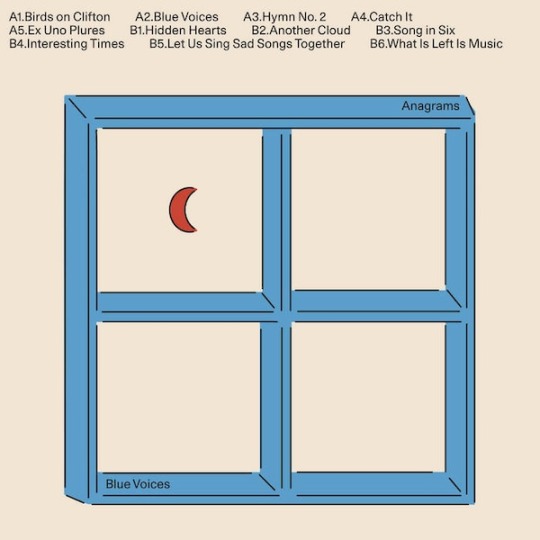
Anagrams - Blue Voices [Balmat] (2023)
Apple / Spotify / Bandcamp

Avalon Emerson - & The Charm [Another Dove] (2023)
Apple / Spotify / Bandcamp

Baba Stiltz - Paid Testimony [Public Possession] (2023)
Apple / Spotify / Bandcamp

Beat Happening - We Are Beat Happening [Domino] (2019)
Apple / Spotify / Bamdcamp / Domino
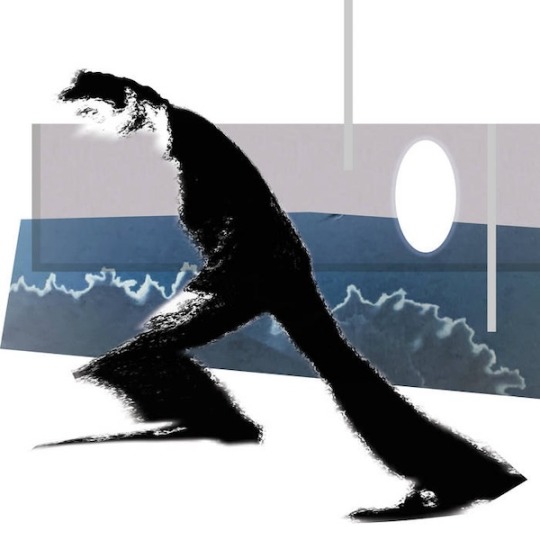
DJ Trystero - Castillo [Incienso] (2023)
Apple / Spotify / Bandcamp

Doc Sleep - Birds (In My Mind Anyway) [Tartelet Records] (2023)
Apple / Spotify / Bandcamp

Earth Trax - Closer Now [Lapsus] (2023)
Apple / Spotify / Bandcamp

Greg Foat & Gigi Masin - Dolphin [Strut] (2023)
Apple / Spotify / Bandcamp
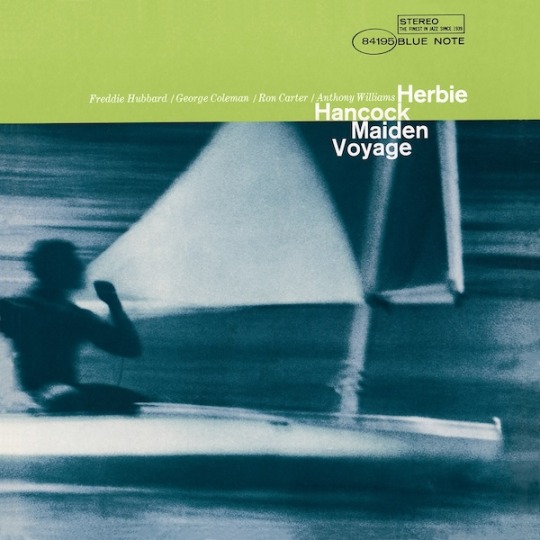
Herbie Hancock - Maiden Voyage [Blue Note] (1965)
Apple / Spotify
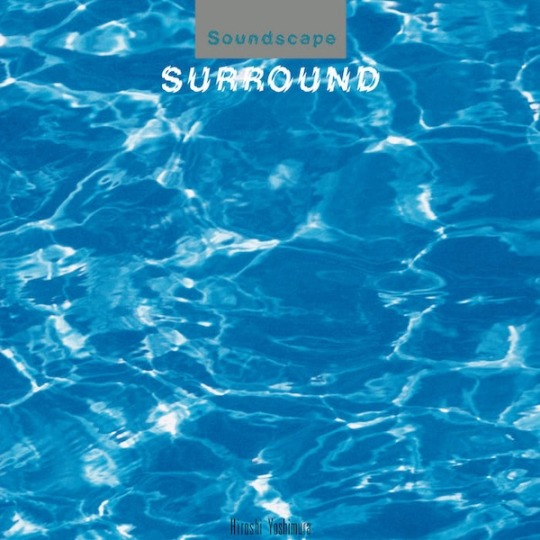
吉村弘 - Soundscape 1: Surround [Misawa Home] (1986)
Apple / Spotify / Bandcamp

Huerta - TV Slang [R&R] (2023)
Apple / Spotify / Bandcamp
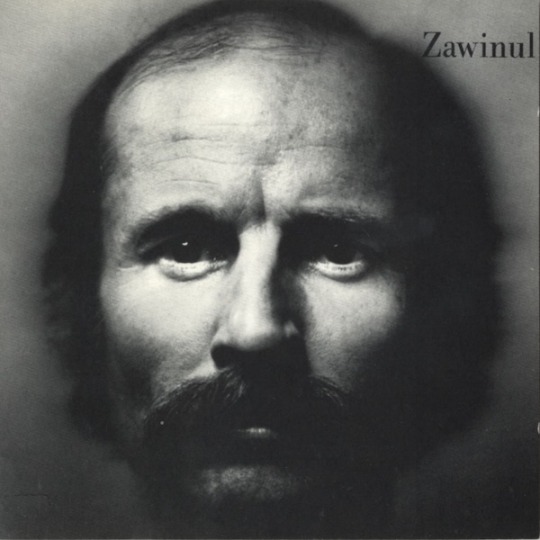
Joe Zawinul - Zawinul [Atlantic] (1971)
Apple / Spotify

Khotin - Release Spirit [Ghostly International] (2023)
Apple / Spotify / Bandcamp
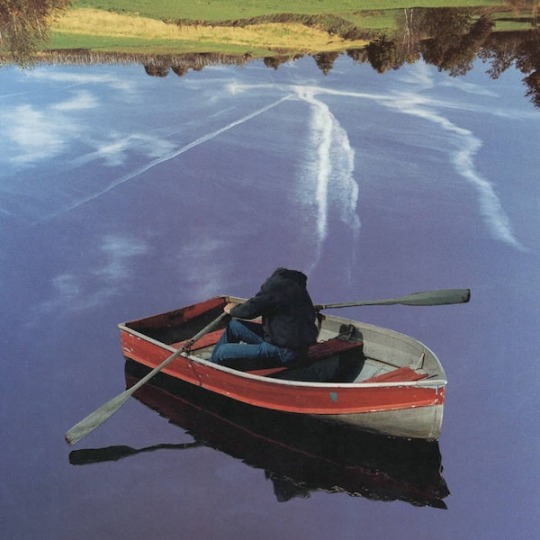
Other Lands – Archipelagos [Athens Of The North] (2022)
Apple / Spotify / Bandcamp

Pharoah Sanders – Pharoah [India Navigation] (1977)
Apple / Spotify / Bandcamp
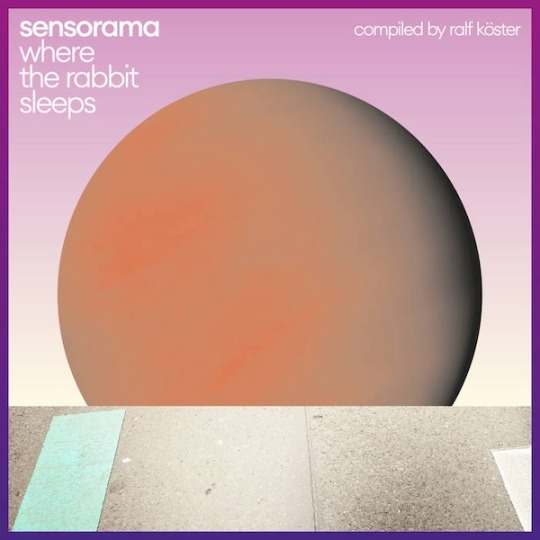
Sensorama - Where The Rabbit Sleeps [Bureau B] (2023)
Apple / Spotify / Bandcamp

SG - For Lovers Only / Rain Suite [Faitiche] (2023)
Apple / Spotify / Bandcamp

本多信介 - サイレンス(夕映え) [ALTY] (1983)
Apple / Spotify / Bandcamp

Solitaire - S.T. [Fax +49-69/450464] (1995)
Bandcamp
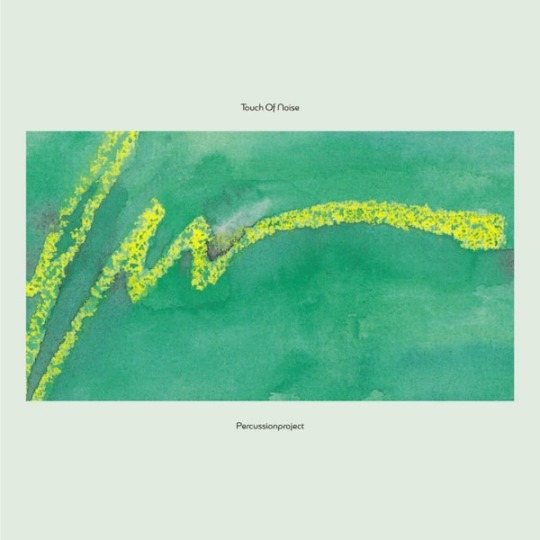
Touch Of Noise - Percussionproject [Mikado Records] (1995)
Apple / Spotify / Bandcamp
吉村弘(未発送)のほかは、すべてレコードで手に入れた。特にお気に入りがSensoramaとBaba Stiltzなのでぜひ聴いていただきたい。
Roman FlügelとJörn Elling WuttkeによるSensoramaは、90年代後半〜00年代はじめにハンブルクのレーベルLadomat 2000からリリースしていた。Roman Flügelが複数の名義で多様な作品を産んできたのと同じく、SensoramaもAlter Ego、Acid Jesus、The Primitive Painterなどの変名を持っている。なかでもSensoramaはテンポはゆったり、音は少なめに手づくり���にあふれていて、優しい温もりがある、でもちょっと風変わり、ときどきとんがり。初めて聴いてすぐに魅せられリピートしまくった。
ふたりともハンブルク出身でも拠点でもないのだが、ライナーノーツを読むとこのアルバムはハンブルク人脈に愛されていたからこそ作られたようだ。Golden Pudel Club(いつか行きたい)のブッキング担当/DJであるRalf Kösterによってコンパイル、Bureau Bからリリースされた。リリース・パーティは当然Pudelで行われ、JörnのSoundcloudでは当日の楽しそうなmix(Part 1とPart 2)を聴くことができる。
待ちに待ったBaba Stiltzのセカンド・アルバムは、その名で人気を獲得したハウスから離れ、近年のシングルの延長で、The Folk ImplosionやBeckの地味目の曲を思い出させるローファイ・フォークという趣。それがほんっっと好み。彼はグランジ風の服装をしていて、Our Legacyのランウェイではモデルとして歩き、VOGUEにスナップされ、DAZEDで特集を組まれるおしゃれさんだ。2018年にInstagramでDinosaur Jr.(私がいちばん好きなバンドのひとつ!)のTシャツを着ているのを目撃して勝手に喜び、それはジョークでもハズしでもなく本当に好きらしく、レジデントを務めるNTS RadioではSonic YouthやPJ Harveyなどオルタナをたくさんかけていたのでずっと共感していたのだった。レーベルのPublic Possessionは、ハウスを通過しつつインディ~オルタナ的表現をするアーティストを紹介してくれるのでよくチェックしている。
このTumblrにお気に入りの音楽リストを投稿し始めたのは2014年だから、もう10年目になる。���く聴いていたアルバムにRoman Flügelの『Fatty Folders』(2011年)や『Happiness Is Happening』(2014年)、ベスト・トラックのひとつにBaba Stiltz“Palats”を挙げていた。それまで好んでいた王道のロックやインディ・ロック、ポップスにプラスして、同世代の友達が聴いてなさそうなエレクトロニック・ミュージックこそが、ひとり暮らしの日常の気分を整えてくれる居心地のよいものとなっていった時期だった。居心地のよさを知ったとして、たいていは自分もアーティストも年月を経て変わっていくことが多いだろう。変わっても認められる、ずっと好きで自分の核というか心の支えになる――大切な存在の音楽を作ってくれるアーティストがいるのはありがたいことだ。
旧譜では、そのうち聴くでしょとスルーしていたが世間的には名盤扱いの、ハービー・ハンコック、ファラオ・サンダース、ジョー・ザヴィヌルの上記のアルバムに今さらハマった。たまたま聴いたら、まるで私のための作品かと感じるほどスッと入ってくる不思議な体験だった。そのとき他に何を聴いていたとか、年齢、気候、体調などにもよるのかもしれない。
昨年書いた「レコードを手に入れたらじっくりリスニング」を心がけたおかげか、他にもお気に入りのレコードがたくさんできてしまったので、そのうちmixにできたらという感じです。
毎年恒例、FRENCH BLOOM NETのベスト音楽に寄稿しました。プレイリスト2023 Best 100+ Tracks(Apple / Spotify)を作ったので聴いてみてください。ライヴとDJ mix音源を詰め込んだプレイリスト2023 Fav Mix & Live(Soundcloud)もどうぞ。
※タイトル、レーベル、リリース年はオリジナルを表記。ジャケ画像はリイシューも使用。Beat Happeningは全部入り的BOXのため、サブスクのリンクはアーティストページにしています。
(いりー)
2 notes
·
View notes
Text
Introduction Virtual Reality (VR) is a latest emerging trend which makes use of the growing power of computers to demonstrate real-world and artificial situations and environments with extensive practicality and interaction. In fact, the primary cause of attraction of virtual reality is its capability to generate tests and experiments near to everyday life with wonderful investigational power (Wyk & Villiers, 2009; Plancher, Nicolas, & Piolino, 2008). The virtual reality has been around us for many years. In view of the fact that it involves so many factors, hence it took a lot of time and efforts to build it what it is nowadays. In addition, the virtual reality is yet a great deal hyped term that carries people to consider on the eternal virtues of this rising technology and paradigm. However, with the passage of time we are observing a lot of real implementations of virtual reality appearing into life (VRS, 2009). This paper presents a detailed overview of virtual reality. In this scenario, this research will cover a lot of aspects which are related to virtual reality such as its history, its associated elements and advantages. History of Virtual Reality The idea of virtual reality has always been in under construction and optional for many years, even though the public simply became aware of it in the early 90s. Basically, the history of virtual reality can be traced back in the mid 50s; when Morton Heilig who was a cinematographer imagined a theatre experience that would excite all his audiences’ senses, catching them into the stories more efficiently. For this purpose, he constructed a single client console in the 60s, which is known as the Sensorama that incorporated fans, a stereoscopic display, stereo speakers, odor emitters and a moving chair. In addition, he as well invented a head-mounted TV to allow the people to watch TV in 3-D. In this scenario, users were passive viewers of the films, however a lot of Heilig’s ideas have discovered their way in the VR field (Strickland, 2012). After that Philco Corporation engineers developed the primary HMD in 1961 that is known as Headsight. The helmet comprised a video screen and tracking system that engineers connected to a high-tech closed circuit camera system. Read the full article
0 notes
Text
VR's Influence on Film and Entertainment
Introduction Virtual Reality (VR) has been heralded as the next frontier in entertainment, promising an immersive experience that could revolutionize the way we consume media. From the earliest days of cinema to the digital revolution, the film and entertainment industries have continually evolved, embracing new technologies to captivate audiences. VR, with its potential to transport viewers into completely new worlds, represents the latest and perhaps most transformative leap. This article explores VR's influence on film and entertainment, examining its technological advancements, creative implications, and the transformative experiences it offers to audiences. Table of Contents - The Evolution of VR Technology - Early Beginnings - Technological Advancements - Accessibility and Adoption - VR in Filmmaking - A New Medium for Storytelling - Pioneering VR Films - Challenges and Opportunities - The Role of Animation and CGI - VR and Interactive Entertainment - The Rise of Interactive Narratives - Case Studies: Interactive VR Experiences - The Role of Game Engines - Immersive Theater and Live Performances - The Impact on the Entertainment Industry - Transforming the Viewing Experience - The Role of Streaming Platforms - The Future of Movie Theaters - Economic Implications - The Human Element: VR's Impact on Audiences - Empathy and Emotional Engagement - Accessibility and Inclusivity - Social and Psychological Effects - Ethical Considerations - The Future of VR in Film and Entertainment - Emerging Trends - The Role of 5G and Cloud Computing - Collaboration and Co-Creation - The Role of Education and Training - The Path Ahead - Conclusion The Evolution of VR Technology Early Beginnings The concept of virtual reality isn't as modern as one might think. The idea of creating immersive experiences dates back to the 1960s when Morton Heilig invented the Sensorama, a multi-sensory simulator designed to create an immersive experience using stereoscopic images, sound, vibrations, and even smell. Although rudimentary by today's standards, the Sensorama laid the groundwork for future VR developments. Technological Advancements Fast forward to the 21st century, and VR technology has seen exponential growth. The development of powerful processors, high-resolution displays, and sophisticated motion tracking has made consumer-grade VR headsets like the Oculus Rift, HTC Vive, and PlayStation VR possible. These advancements have not only enhanced the visual and auditory aspects of VR but also incorporated haptic feedback to create a more tactile and engaging experience. Accessibility and Adoption As VR technology has advanced, it has also become more accessible. The introduction of affordable headsets and the proliferation of smartphone-based VR solutions have lowered barriers to entry. This democratization of VR technology has allowed a broader audience to experience virtual reality, fostering an environment ripe for innovation in film and entertainment. VR in Filmmaking A New Medium for Storytelling VR has introduced a new dimension to storytelling, offering filmmakers an unprecedented level of creative freedom. Traditional films are constrained by the rectangular frame of the screen, but VR allows for a 360-degree field of vision, immersing viewers in the story world. This shift from passive viewing to active participation demands a rethinking of narrative structures and cinematic techniques. Pioneering VR Films Several filmmakers have already begun experimenting with VR to create immersive narratives. One notable example is Alejandro G. Iñárritu's "Carne y Arena," a VR installation that places viewers in the shoes of immigrants attempting to cross the U.S.-Mexico border. The experience's visceral impact highlights VR's potential to evoke empathy and foster a deeper connection with the story. Challenges and Opportunities of VR's Influence on Film and Entertainment While VR offers exciting possibilities, it also presents unique challenges. One of the main hurdles is the need for new storytelling conventions. Traditional editing techniques, such as cuts and transitions, can be disorienting in VR. Filmmakers must find innovative ways to guide the viewer's attention within a 360-degree space. Additionally, the high cost of producing VR content and the need for specialized equipment can be prohibitive for some creators. The Role of Animation and CGI Animation and computer-generated imagery (CGI) play a crucial role in VR filmmaking. Unlike live-action shooting, which requires 360-degree sets and cameras, animation allows for complete control over the virtual environment. This control enables creators to design intricate worlds and manipulate them in ways that would be impossible in live-action films. For instance, "Pearl," a VR animated short by Google Spotlight Stories, uses seamless transitions and spatial storytelling to create an emotionally resonant experience. VR and Interactive Entertainment The Rise of Interactive Narratives Beyond traditional storytelling, VR has opened up possibilities for interactive entertainment, where viewers can influence the outcome of the narrative. This interactivity blurs the line between film and video games, creating a hybrid form of entertainment that engages the audience in new ways. Case Studies: Interactive VR Experiences One of the most acclaimed interactive VR experiences is "The Invisible Hours," a murder mystery where viewers can explore the scene and follow different characters to uncover the plot. This non-linear approach to storytelling allows for multiple perspectives and encourages repeated viewings, offering a unique and personalized experience each time. The Role of Game Engines Game engines like Unity and Unreal Engine have become essential tools for creating interactive VR experiences. These engines provide the technical framework for building complex virtual environments and integrating interactive elements. Their versatility and power have made them popular choices for both game developers and filmmakers venturing into VR. Immersive Theater and Live Performances VR has also made its mark in immersive theater and live performances. Productions like "Sleep No More" have inspired VR adaptations that allow audiences to explore virtual sets and interact with actors in real-time. These experiences merge the intimacy of live theater with the limitless possibilities of virtual worlds, creating a new form of entertainment that is both immersive and interactive. The Impact on the Entertainment Industry Transforming the Viewing Experience VR has the potential to transform the traditional viewing experience, offering audiences a more immersive and engaging way to consume media. Unlike conventional films, which are viewed on a screen, VR places viewers inside the story, making them active participants rather than passive observers. This shift in perspective can create more emotionally impactful experiences and foster a deeper connection with the content. The Role of Streaming Platforms Streaming platforms like Netflix and Hulu have begun to explore VR content, offering 360-degree videos and immersive experiences. These platforms have the potential to bring VR to a wider audience, making it a mainstream form of entertainment. Additionally, the integration of VR with streaming services could lead to new business models and revenue streams for content creators. The Future of Movie Theaters The rise of VR has also sparked discussions about the future of movie theaters. While traditional theaters offer a communal viewing experience, VR provides a more personalized and immersive alternative. Some industry experts believe that VR could complement rather than replace traditional theaters, offering a different type of experience for audiences. For example, VR arcades and theaters have started to emerge, providing a venue for people to experience VR content in a social setting. Economic Implications The adoption of VR in film and entertainment has significant economic implications. The production of VR content requires new skills and expertise, creating job opportunities in areas such as VR development, animation, and interactive design. Additionally, the demand for VR hardware and software has the potential to drive growth in the tech industry, fostering innovation and competition. The Human Element: VR's Impact on Audiences Empathy and Emotional Engagement One of the most profound impacts of VR is its ability to evoke empathy and emotional engagement. By placing viewers in the shoes of different characters, VR can create a sense of presence and immersion that is difficult to achieve with traditional media. This emotional connection can make stories more impactful and memorable, fostering a deeper understanding of different perspectives and experiences. Accessibility and Inclusivity VR also has the potential to make entertainment more accessible and inclusive. For individuals with disabilities, VR can offer new ways to experience and interact with content. For example, VR can provide immersive experiences for people who are unable to attend live events or visit physical locations. Additionally, the development of accessible VR interfaces and content can ensure that a wider audience can enjoy the benefits of this technology. Social and Psychological Effects While VR offers numerous benefits, it also raises questions about its social and psychological effects. Prolonged use of VR can lead to issues such as motion sickness and eye strain. Additionally, the immersive nature of VR can blur the lines between reality and virtual experiences, raising concerns about its impact on mental health. It is essential for creators and researchers to address these issues and develop guidelines for safe and responsible use of VR. Ethical Considerations The use of VR in entertainment also raises ethical considerations. The ability to create realistic and immersive experiences can be a powerful tool, but it also comes with responsibilities. For example, the use of VR to depict traumatic events or violent content must be handled with care to avoid causing harm to viewers. Additionally, issues related to privacy and data security must be addressed, as VR experiences often involve the collection of personal data. The Future of VR in Film and Entertainment Emerging Trends As VR technology continues to evolve, several emerging trends are shaping the future of VR in film and entertainment. One such trend is the integration of augmented reality (AR) and mixed reality (MR) with VR, creating hybrid experiences that blend the virtual and physical worlds. Additionally, advancements in artificial intelligence (AI) and machine learning are enabling more sophisticated and personalized VR experiences. The Role of 5G and Cloud Computing The rollout of 5G and advancements in cloud computing are expected to have a significant impact on the future of VR. The increased bandwidth and lower latency of 5G networks will enable more seamless and high-quality VR experiences, while cloud computing will allow for the processing and storage of complex VR content. These technological advancements will make VR more accessible and scalable, opening up new possibilities for creators and audiences alike. Collaboration and Co-Creation Collaboration and co-creation are also emerging trends in VR. Platforms like VRChat and AltspaceVR allow users to create and share their own virtual experiences, fostering a sense of community and collaboration. This user-generated content model has the potential to democratize VR creation, allowing a diverse range of voices and perspectives to contribute to the medium. The Role of Education and Training Beyond entertainment, VR is being used in education and training, offering immersive and interactive learning experiences. From virtual classrooms to medical simulations, VR has the potential to revolutionize education and professional training, providing engaging and effective ways to acquire new skills and knowledge. The Path Ahead The future of VR in film and entertainment is full of possibilities. As technology continues to advance, the boundaries of what is possible in VR will continue to expand. However, it is essential for creators, technologists, and policymakers to work together to address the challenges and ethical considerations associated with this powerful medium. By doing so, they can ensure that VR remains a force for creativity, innovation, and positive impact. Conclusion Virtual Reality has the potential to transform the film and entertainment industries, offering new ways to tell stories, engage audiences, and create immersive experiences. From pioneering VR films to interactive narratives and live performances, VR is pushing the boundaries of what is possible in entertainment. While there are challenges and ethical considerations to address, the future of VR in film and entertainment is bright, with endless possibilities for innovation and creativity. As we continue to explore and embrace this exciting medium, we can look forward to a future where VR is an integral part of our entertainment landscape, enriching our lives and expanding our horizons. In the ever-evolving world of film and entertainment, VR stands out as a transformative force, promising to reshape how we experience stories and connect with content. As technology advances and creators continue to push the boundaries, the impact of VR will only grow, offering new and exciting possibilities for audiences and creators alike. The journey is just beginning, and the future of VR in film and entertainment is a thrilling adventure waiting to unfold. ``` Read the full article
0 notes
Text
La Notable Evolución De La Realidad Virtual
El origen de la realidad virtual
Antonin Artaud acuñó el término “realidad virtual” en 1938, describiéndolo como “teatro de la mente”, aunque el concepto de realidad virtual existe desde hace mucho más tiempo. Los primeros ejemplos de realidad virtual se pueden encontrar en el siglo XIX, con pinturas panorámicas e imágenes generadas por computadora.
Además, en 1935, Stanley G. Weinbaum publicó “Pygmalion's Spectacles”, un libro sobre un espectacular par de gafas que podían transportar a los usuarios a un mundo ficticio.
Morton Heilig inventó el Sensorama, uno de los primeros sistemas de realidad virtual que simula todos los sentidos, en 1957. En 1968, Ivan Sutherland inventó la Espada de Damocles , ampliamente considerada como el primer visor de realidad virtual. Este dispositivo grande y costoso sólo se utilizó para investigación.
Muchos años después, en 2010, Oculus VR, que luego fue adquirida por Meta, lanzó el primer visor de realidad virtual moderno. Desde entonces, la tecnología de realidad virtual ha avanzado, con nuevos auriculares lanzados por empresas como HTC, Sony y Microsoft.
Avances en la tecnología de realidad virtual
El desarrollo del Head-Mounted Display (HMD), un dispositivo que permitía a los usuarios sumergirse en un entorno virtual, fue uno de los avances más significativos en la tecnología de realidad virtual. Fue utilizado por primera vez por los pilotos que se entrenaban en la industria de la aviación en la década de 1960.

Con el desarrollo de imágenes generadas por computadora (CGI) y gráficos 3D en la década de 1980, los sistemas de realidad virtual se volvieron más sofisticados. Este avance permitió la creación de mundos virtuales más realistas, lo que impulsó el crecimiento de los juegos y el entretenimiento de realidad virtual.
El lanzamiento de los primeros cascos de realidad virtual disponibles comercialmente, como el sistema Virtuality, en la década de 1990 supuso mayores avances en la tecnología de realidad virtual. Esta década también vio el auge de la realidad virtual en la educación y la formación, utilizándose la realidad virtual para simular entornos peligrosos y preparar a los estudiantes para situaciones del mundo real.
Con el desarrollo de imágenes generadas por computadora (CGI) y gráficos 3D en la década de 1980, los sistemas de realidad virtual se volvieron más sofisticados. Este avance permitió la creación de mundos virtuales más realistas, lo que impulsó el crecimiento de los juegos y el entretenimiento de realidad virtual..
Evolución a través del juego
La industria del juego ha sido una fuerza impulsora importante en el avance de la tecnología de realidad virtual. Algunos de los primeros juegos de realidad virtual, como “Battlezone”, se crearon en los años 80. Aunque eran primitivos para los estándares actuales, brindaron a los jugadores una idea de cómo podrían ser los juegos de realidad virtual.
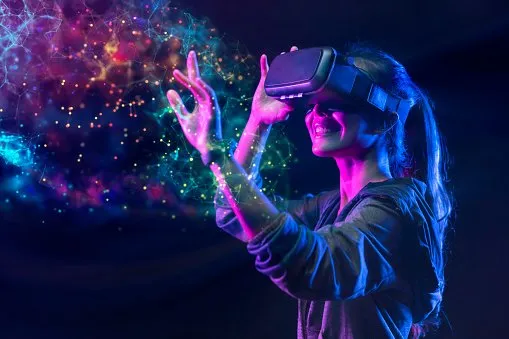
Los juegos de realidad virtual más avanzados despegaron en la década de 1990 con el lanzamiento de “ Dactyl Nightmare ” y Nintendo Virtual Boy, dos de los primeros juegos de realidad virtual en utilizar el seguimiento de la cabeza. Hoy en día, los juegos de realidad virtual han avanzado significativamente, con numerosos juegos de realidad virtual disponibles para plataformas como Oculus Rift, HTC Vive y PlayStation VR
La evolución de la realidad virtual en la educación
Desde entonces, la realidad virtual se ha utilizado en una variedad de aplicaciones educativas , incluido el aprendizaje de idiomas, el entrenamiento de anatomía y las simulaciones históricas. Si bien este no era el propósito original de la realidad virtual, su popularidad ha ganado en los últimos años.
Debido a que la realidad virtual se puede utilizar para simular entornos del mundo real, ofrece a los estudiantes una oportunidad única de aprender nuevas habilidades y conocimientos en un entorno seguro y controlado. Como resultado de esto, la realidad virtual se ha convertido en una herramienta invaluable para los educadores de todo el mundo.
Referencia:
* XpertVR (2021). The Remarkable Evolution Of Virtual Reality. https://xpertvr.ca/the-remarkable-evolution-of-virtual-reality/
0 notes
Text
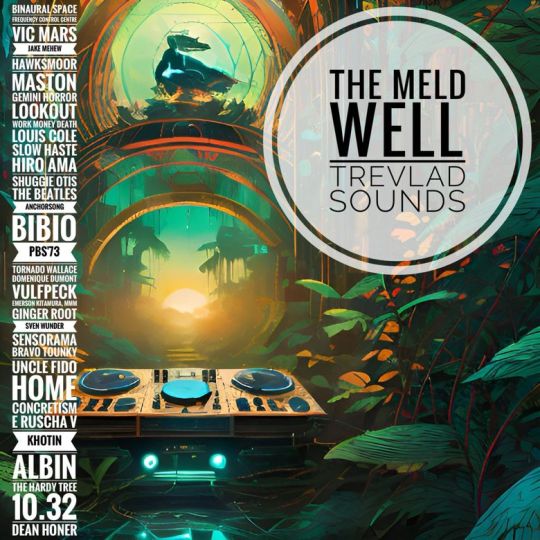
Binaural Space-Revolutions Per Millenium 00:00
Frequency Control Centre-Meramorphic Plane 00:54
Vic Mars-The Fair Arrives 05:15
Jake Mehew-The Black Nation 09:34
Hawksmoor-A Neural Interval 15:41
Maston-Jet Lag 16:40
Gemini Horror-All of the Proud 18:54
Lookout-arcadia 21:46
Work Money Death-Freedom as a Heartfelt Song 26:28
Louis Cole-Let it Happen (old version) 37:01
Slow Haste-Forest Instance 39:25
Hiro Ama-Warp 41:52
Shuggie Otis-Island Letter 44:27
The Beatles-Lucy In The Sky With Diamonds 48:59
Anchorsong-Ceremony 52:18
Bibio-Clay Dots 56:18
PBS'73-Butterfly Inside 59:14
Tornado Wallace-Trance Encounters 1:03:23
Domenique Dumont-Le Soleil Dans Le Monde 1:08:33
Vulfpeck-Earworm 1:12:25
Emerson Kitamura, MMM-Rock Your Baby 1:14:48
Ginger Root-Multiply 1:19:58
Sven Wunder-En Plein Air 1:22:19
Sensorama-Where the Rabbit Sleeps 1:24:50
Bravo Tounky-Chemnitz 1:29:24
Uncle Fido-They Make a Decision 1:33:11
HOME-35 1:34:45
Concretism-Incident on the A1075 1:36:42
E Ruscha V-Sliding Around 1:39:36
Khotin-Computer Break (Late Mix) 1:42:55
Albin-Tacksam 38 1:47:20
The Hardy Tree-Stagdale in the Snow 1:52:56
10.32-Cornelius Drive 1:56:56
Dean Honer-De Da Dumplings 2:01:01
#Binaural Space#Frequency Control Centre#Audionautic Records#Vic Mars#Clay Pipe Music#Jake Mehew#ATA Records#Hawksmoor#Soul Jazz Records#Maston#Gemini Horror#Mystery Circles#Lookout#Work Money Death#Louis Cole#Brainfeeder#Slow Haste#Hiro Ama#PRAH Recordings#Shuggie Otis#Epic#The Beatles#Parlophone#Anchorsong#Tru Thoughts#Bibio#Warp Records#PBS'73#Magic Square Records#Tornado Wallace
3 notes
·
View notes
Text
Terminal 6 en concierto sala Sensorama 16-05-2009
youtube
0 notes
Text
vimeo
Sensorama visit by Itsuo Sakane, Asahi Shimbun - USC-MEML
0 notes
Text
10.Pushing Limits VR, AR, MR technologies - Even better than reality? analysis
In this blog post I will discuss the different paths virtual reality may take and the relation between how we perceive reality and how we perceive virtual reality. I will also present my opinion regarding the functionality of augmented reality, as well as the connection between the immersive experience and interactivity of VR (virtual reality).
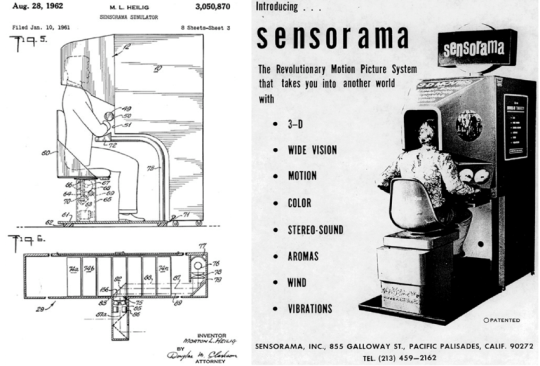
Fig.1 Sensorama
Since 1962 when Morton Heiling created Sensorama (fig.1), the first virtual reality machine, people have been trying to create and perfect this virtual world that would help people experiment with new sensations and worlds that otherwise, reality wouldn’t allow. The founder president of Center for Complexity Studies (U.N.E.S.C.O. centre and main promoter of Complexity theory in Romania), Florin Munteanu states on his website: “The past has become unfitting and the future hasn’t found its shape yet” (Florin Munteanu,2016). This further underlines my opinion that at one point, reality became insufficient or unattractive for some exploring minds, leading to the creation of a new digitised reality. In the 1980s Jaron Lanier invented the term “virtual reality”, with the intention that it would make television and gaming more engaging. In 1984 he founded V.P.L, the first company to sell virtual reality technology.
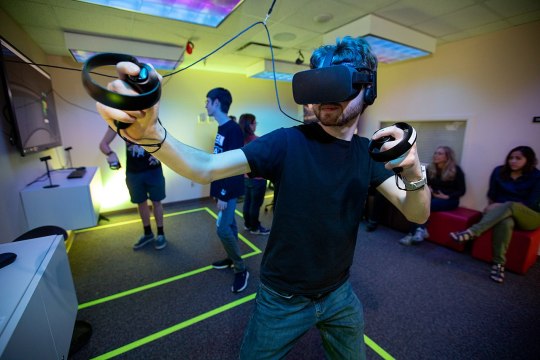
Fig.2: VR gaming set
As technology evolved, VR gaming (fig.2) became more and more accessible and understood by researchers and the wide public. Since 2019 when Oculus Quest took shape and Meta started developing the metaverse, a lot of game studios also started exploring the virtual reality possibilities. In the article “Virtual Reality Gaming Market Size & Share Analysis - Growth Trends & Forecasts (2023 - 2028)”, it is stated that “according to NewGenApps, by 2025, the worldwide user base of AR and VR games is expected to increase to 216 million users” (Virtual reality Gaming Market - trends & companies). This shows a huge increase in the V.R. gaming industry.
As the virtual reality extends, its functionality will be branched in multiple disciplines. I believe in the future, VR will help people like architects and engineers visualise complex projects and from perspectives that would be impossible to reach in real life. However, even with its tremendous potential to ease workflows, these days virtual and augmented reality is mostly used in entertainment “according to 3Dinsider, more than 64% of active VR users believe that gaming has the highest potential to benefit from advances in VR technology.” (Virtual reality Gaming Market - trends & companies). This duality of purpose can also be seen in the film and game industry. The film industry has documentaries and studies, as well as entertainment films. Using the same pattern, the game industry has epistemic as well as entertainment games. As a result, I believe virtual and augmented reality do not have a preferred path, both functions (the entertainment and work) will keep evolving simultaneously as a need for future development.

Fig.3: Beat Saber
VR gaming received a lot of diversity when it comes to its game genres in the last few years. Starting with abstract games like Beat Saber (fig.3) which mainly focus on interactivity, up to story based immersive games like exploration, for example Nefertari VR: Journey to Eternity (2018) or horror games, for example Resident Evil Village (2021). These kinds of games allow the player to fully experience dangerous situations in a safe and controlled environment.
youtube
Fig.4 realistic VR games
According to Baudillard(1983:11) there are four phases of the image. First phase contains the images as a reflection or reality (fig.4), which refers to realistic simulations (driving/flying simulations, safari trips etc.). Second phase refers to images that are masking or perverting reality. Imagery like this is used in war and combat games such as Call of Duty, which diminishes the horrors of real life war as entertainment. I believe this kind of imagery to be a very sensitive edge, as it desensitises people and can subconsciously influence children and teenagers to become more violent, if not being supervised and kept under control. Third and fourth phases refer to the imagery that goes beyond reality, a pure simulation. I believe these categories refer to the fantasy, futuristic or abstract worlds that we can’t find in our day to day lives.
Unlike films, in which the viewer needs to be a passive element for the immersive experience, games need the player to be active in order to progress. Researchers such as Marie-Laure Ryan believe that “interaction opposes immersivity and vividness” (Ryan 2003), underlining that in order to have a fully immersive experience guided by emotion, the player needs to be a passive element. However, removing the interactive element from the experience would cancel the fundamental part of a game. In addition, I consider that interaction is part of reality. We constantly interact with different elements in order to progress in our daily lives. As a result, from my perspective, interactivity wouldn't reduce the immersive experience, but with a good balance, it would be beneficial.
To conclude, as technology advances, virtual and augmented reality will slowly start to be more and more part of our daily life. Even though VR mostly grows in the gaming industry, I believe in the future its functionality will spread in different areas being also valued in the working areas. The potential of the new virtual world is limitless and opens the gates to new sensations, experiments and fascinating opportunities.
Bibliography:
Fig.1: Researchgate.net. Available at: https://www.researchgate.net/figure/Sensorama-the-first-virtual-immersion-system-the-technical-table-and-the-pictures-shown_fig1_321142137 (Accessed: January 2, 2024).
Fig.2: Wikipedia contributors (2023h) Virtual reality game, Wikipedia, The Free Encyclopedia. Available at: https://en.wikipedia.org/w/index.php?title=Virtual_reality_game&oldid=1183306571.
Fig.3: Dvorak, M. (2023) Beat Saber launches on PS VR2 today with new Queen Music Pack, PlayStation.Blog. Available at: https://blog.playstation.com/2023/05/24/beat-saber-launches-on-ps-vr2-today-with-new-queen-music-pack/ (Accessed: January 2, 2024).
Fig.4: NerdVid (2018) 10 virtual reality experiences that are too realistic and immersive. Youtube. Available at: https://www.youtube.com/watch?v=9TCHlT3B24w (Accessed: January 2, 2024).
Pcmag.com. Available at: https://www.pcmag.com/picks/the-best-vr-games (Accessed: January 2, 2024).
Virtual reality Gaming Market - trends & companies (no date) Mordorintelligence.com. Available at: https://www.mordorintelligence.com/industry-reports/virtual-reality-in-gaming-market (Accessed: January 2, 2024).
Lutkevich, B. (2023) virtual reality gaming (VR gaming), WhatIs. TechTarget. Available at: https://www.techtarget.com/whatis/definition/virtual-reality-gaming-VR-gaming (Accessed: January 2, 2024).
Monika (2023) Hyperrealistic virtual reality - how far away are we?, Linde. Available at: https://vr.linde.com/2023/01/23/hyperrealistic-virtual-reality-how-far-away-are-we/ (Accessed: January 2, 2024).
Petersen, G. B., Petkakis, G. and Makransky, G. (2022) “A study of how immersion and interactivity drive VR learning,” Computers & education, 179(104429), p. 104429. doi: 10.1016/j.compedu.2021.104429.
0 notes
Text
November 2023 Top Ten
Black dog Productions - Bytes (Warp)
Beware The Stare
Generation X by Douglas Coupland
LEGO Star Wars The Razor Crest™
Afterlands - I Woke to the Sound of the Wind (Lost Map)
Coffee and Walnut cake @ Kember and Jones
Sensorama - Aspirin (Global Communication Remix)
Rogue One
Donnie Darko
Exposé - Point Of No Return
0 notes
Text
Blog Post 10
Virtual Reality: What are the limits?
In this day and age, we consumers are privileged to witness the advancement of technology. The people of our century have the opportunity to utilise many provided tools that previous generations never even considered to be possible, as well as the capabilities that come along with it. Devices, software and social media are consistently evolving. So, from now, how long would it take for media to become fully embraced by the real world?
In the fields of entertainment, likely not very long. Games have been on a rise of popularity since its focus in CGI, and signs show how they continue to thrive; their integration into real-life has been recently introduced to the mass audience through the wonders of Virtual Reality (VR).
For this text, I would like to introduce the topic of virtual reality (VR) and explore the both the promises it could hold, as well as the precedent it could set for the future of gaming, let alone media consumption. VR was essentially a developmental concept "aptly termed by Jaron Lanier" during the 1980s, when the computer interface offered viewers a 'virtual world' that they could enter in (Heim, 1994, p. 17). However, the development of VR itself was derived from various products dating further back into the 20th century. Myron Krueger developed Videoplace (circa 1975) to assess artificial reality, as well as publishing a pioneering book titled after the term, Artificial Reality (1983). Earlier events featuring the development of VR stems from the inventions of both Ivan Sutherland and Bob Sproull's Sword of Damocles (1965-1968) and Morton Heilig's Sensorama (1955-1962). Regarded as the first VR head-mounted computer display invented, Sutherland is arguably the historical predecessor to today's VR helmets. (Rheingold, 1991, p. 58) (Figure 1).
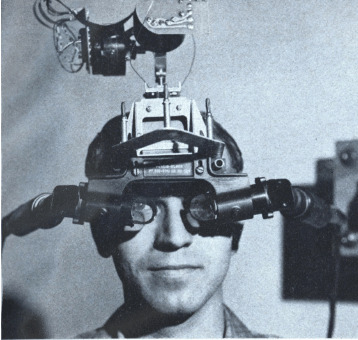
Figure 1
Despite this, the creations of VR has evolved and preceded overtime; it can been argued that the earliest traces of VR are set back into the nineteenth century, through attempts of 'real-life' illusions using panoramic paintings (Figure 2). Their purpose was to provide their viewers an entire field of vision, which has now evolved into 'point of view' (POV), a crucial asset in creating immersion within games.

Figure 2: Battle of Borodino (Roubaud, 1812)
More could be further explored if we were focused on exploring the concept and foundations of VR, as well as the theories behind it. However, I will prioritise the subject of VR as a tool and potential for gaming media in this submission. Regarding the various products of VR that were mentioned, they communicate a specific aim: to immerse viewers into a different world. In Rheingold's words, creating a "completely convincing illusion that one is immersed in a world that exists only inside a computer" (Rheingold, 1991, p. n1).
With this in mind, current games involving VR are exactly that; a compelling cyberspace allowing people to become immersed in. Immersion is a definite trait associated with VR, and is utilised heavily in VR games we can purchase today.
An example of immersion within VR is a popular community game VRChat (2014), an online platform where multiple users can interact with one another through VR. Users can integrate themselves within a fictional setting and customise their 3D avatars to express themselves (Figure 3). The idea of immersion within this product refers to the idea of escapism, by implementing yourself into a 'world' representing the opposite of real-life. Thus, this game holds many possibilities for creativity, such as skits, roleplays, and entertaining interactions with users from all around the internet. YouTube holds a massive category of videos exploring VRChat, as well as a consistent fanbase for it, despite many years since its release.

Figure 3
Thus, the prospect of VR could imply a future involving a more integrative approach to media. The possibilities that VRChat has brought to gaming encourages a precedent where products aside from this medium may be compatible with VR technology, and even sooner than we think; VRChat has already demonstrated a new capability of VR, through the socialisation of its community. This aligns with the predictions found within the foreword of Rheingold's book: that virtual reality will soon affect everyone's daily life - "in everything from communication to education, from business to sex" (Rheingold, 1991, p. n1). This example shown in later years from the book's release presents a credible point from Rheingold that this generation is indeed going through a technological revolution through VR, which could further progress and "take us into the next century - and beyond" (ibid, p. n1).
Despite this, with the new shift in technology, comes with new setbacks to resolve. It can be argued that the reason for the success of VRChat is because of its socialisation feature - had it not offered its users that, the virtual worlds inside its gameplay would not be as exciting or revolutionary. Thus, without any stimulants of interactivity, VR would merely resemble a husk of a game; an empty shell of a product.
This makes sense, given the origin of VR. It was not invented for entertainment, but rather for education. Rheingold states that part of VR technology was derived from flight simulators that the United States Air Force trained their pilots with (Rheingold, 1991, p. 16). Within these simulators, pilots learn about the basic mechanism of aircrafts "without leaving the ground, by practicing with a replica of airplane controls" (ibid, p. 16).
In relation to military use, Rheingold also claims The National Aeronautics and Space Administration's (NASA) involvement within VR technology, regarding their contribution to VR models. NASA configured a system for VR technology by providing "high-tech" helmets to pair with "electronic-shutter glasses" during the 1980s (ibid, p. 17). In addition, NASA's provided system allowed the feasibility of affordable VR sets, thus peaking the mass' interest in pursuing research and development (R & D) into VR, resulting in the establishment of VR industries to be founded within the 1990s (Ibid. p. 133). Due to NASA's involvement, VR sets could be produced inexpensively, which Rheingold speculated this being behind the success of VR within the aforementioned simulators; "the Air Force had been flying million-dollar helmets for years" (Ibid. p. 133).
All of these variables further corresponds to the fact that VR technology was, while still in development, never intended for entertainment. This is further cemented by the fact that Ivan Sutherland, leading pioneer of VR, had a specific motive behind his invention. Originally, Sutherland envisioned VR to allow its users the experience to "create the mathematical model of the virtual world in the computer", enabling them to "look, feel, and sound as much as possible like a real world to the human mind that is coupled with it" (Ibid. p. 38). Therefore, the initial purpose behind VR was to integrate simulation with reality, not just simply representing it, hence the educational factors surrounding VR at the time.
That said, it could be argued that Sutherland's view would never have come to fruition, due to the threat of uncanny valley within such a simulation; Masahiro Mori theorises that if a representation of human likeness increases, the viewer's affinity decreases (Rhee, 2013, p. 303). Mori argues that concepts like prosthetic arms are a combination of human and non-human features, thus causing an eerie and cold sense of feeling in the viewer (MacDorman, and Chattopadhyay, 2016, pg 190). Recent scholar studies applying uncanny valley to three-dimensional (3D) film characters closely resembling humans found that their viewers "failed to identify with the characters, experiencing them instead as soulless or vacant" (Ibid. p. 190).
So, what does this mean for the VR technology and its future?
While the reasons behind the creation of VR may not have panned out the way its pioneers had imagined, that is not to say that the current expansion of VR and its promises of 'reality' is all for not. VR still has the potential to completely renovate how we consume media, though the process of its simulation will no longer be focused on capturing reality itself, but rather representations of it. Furthermore, this leaves a lot of concepts to experiment with in 'bringing to life'. Since nothing in VR is real anyway, why merely stick to realistic elements, when creators could produce a world for viewers to fully experience their fiction?
This is where the revolution of VR takes place; if its technology refrains from mimicking reality and instead embraces its fictionality, then the advantage of its immersion would perform best. Entirely fictional, even two-dimensional (2D) based works could be revolutionised through the use of VR; Rick and Morty: Virtual Rick-ality (2017) proves this statement. Despite the obvious cartoon style, the show's VR adaptation allows fans to experience a depiction of Rick and Morty (2013-2023) as if they are part of an episode (Figure 4). This corresponds to Rheingold's recollection of his experience with VR: "Cyberspace was everywhere I looked - above me, below me, behind me. I wasn't just watching it. I was in it" (Rheingold, 1991, p. 133).

Figure 4
In conclusion, while its conventions are still relatively new to the mass, VR has long been studied and finally figured out. The prospect it holds for media is profound, with the success of gaming experience being evident. The diversion in the initial perspective for VR has ended up giving this promising piece of technology a second chance, through further development within the entertainment industry (Ibid. p. 46). Overall, this generation can witness the breakthrough of technological experience, in which VR has the capability to provide.
Sources:
Adult Swim Games (2014) Rick and Morty: Virtual Rick-ality [Video game]. Available at: https://store.steampowered.com/app/469610/Rick_and_Morty_Virtual_Rickality/ (Accessed: 27 December 2023).
Franz Roubard (1812) Battle of Borodino [Painting]. Borodino Battle Museum Panorama, Moscow (Viewed: 27 December 2023).
Heim, M. (1994) The Metaphysics of Virtual Reality. Oxford: Oxford University Press.
MacDorman, K.F. and Chattopadhyay, D. (2016) ‘Reducing consistency in human realism increases the uncanny valley effect; increasing category uncertainty does not’, Cognition, 146, p. 190.
Norman, J.M. (2024) HistoryofInformation.com. Available at: https://www.historyofinformation.com/detail.php?id=861 (Accessed: 27 December 2023).
Norman, J.M. (2024) HistoryofInformation.com. Available at: https://www.historyofinformation.com/detail.php?id=2785 (Accessed: 27 December 2023).
Norman, J.M. (2024) HistoryofInformation.com. Available at: https://www.historyofinformation.com/detail.php?entryid=4699 (Accessed: 27 December 2023).
Rhee, J. (2013) ‘Beyond the Uncanny Valley: Masahiro Mori and Philip K. Dick's Do Androids Dream of Electric Sheep?’, Configurations (Baltimore, Md.), 21(3), pp. 301–329.
Rheingold, H. (1991) Virtual reality. Secker & Warburg.
'Videoplace' (2022) Wikipedia. Available at: https://en.wikipedia.org/wiki/Videoplace (Accessed: 27 December 2023).
Virtual Reality Society (2017) History of Virtual Reality. Available at: https://www.vrs.org.uk/virtual-reality/history.html (Accessed: 27 December 2023).
VRChat, Inc. (2014) VRChat [Video game]. Available at: https://hello.vrchat.com/ (Accessed: 27 December 2023).
0 notes